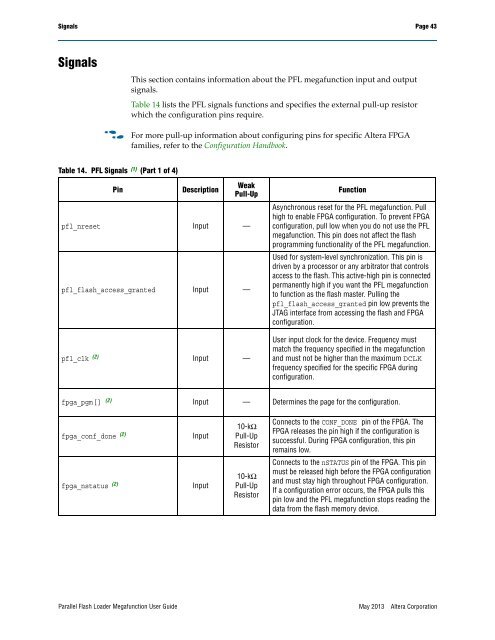Parallel Flash Loader Megafunction User Guide (PDF) - Altera
Parallel Flash Loader Megafunction User Guide (PDF) - Altera
Parallel Flash Loader Megafunction User Guide (PDF) - Altera
You also want an ePaper? Increase the reach of your titles
YUMPU automatically turns print PDFs into web optimized ePapers that Google loves.
Signals Page 43<br />
Signals<br />
This section contains information about the PFL megafunction input and output<br />
signals.<br />
Table 14 lists the PFL signals functions and specifies the external pull-up resistor<br />
which the configuration pins require.<br />
f<br />
For more pull-up information about configuring pins for specific <strong>Altera</strong> FPGA<br />
families, refer to the Configuration Handbook.<br />
Table 14. PFL Signals (1) (Part 1 of 4)<br />
Pin<br />
Description<br />
Weak<br />
Pull-Up<br />
pfl_nreset Input —<br />
pfl_flash_access_granted Input —<br />
pfl_clk (2) Input —<br />
Function<br />
Asynchronous reset for the PFL megafunction. Pull<br />
high to enable FPGA configuration. To prevent FPGA<br />
configuration, pull low when you do not use the PFL<br />
megafunction. This pin does not affect the flash<br />
programming functionality of the PFL megafunction.<br />
Used for system-level synchronization. This pin is<br />
driven by a processor or any arbitrator that controls<br />
access to the flash. This active-high pin is connected<br />
permanently high if you want the PFL megafunction<br />
to function as the flash master. Pulling the<br />
pfl_flash_access_granted pin low prevents the<br />
JTAG interface from accessing the flash and FPGA<br />
configuration.<br />
<strong>User</strong> input clock for the device. Frequency must<br />
match the frequency specified in the megafunction<br />
and must not be higher than the maximum DCLK<br />
frequency specified for the specific FPGA during<br />
configuration.<br />
fpga_pgm[] (2) Input — Determines the page for the configuration.<br />
fpga_conf_done (2)<br />
Input<br />
10-kΩ<br />
Pull-Up<br />
Resistor<br />
Connects to the CONF_DONE pin of the FPGA. The<br />
FPGA releases the pin high if the configuration is<br />
successful. During FPGA configuration, this pin<br />
remains low.<br />
Connects to the nSTATUS pin of the FPGA. This pin<br />
must be released high before the FPGA configuration<br />
and must stay high throughout FPGA configuration.<br />
If a configuration error occurs, the FPGA pulls this<br />
pin low and the PFL megafunction stops reading the<br />
data from the flash memory device.<br />
fpga_nstatus (2)<br />
Input<br />
10-kΩ<br />
Pull-Up<br />
Resistor<br />
<strong>Parallel</strong> <strong>Flash</strong> <strong>Loader</strong> <strong>Megafunction</strong> <strong>User</strong> <strong>Guide</strong><br />
May 2013<br />
<strong>Altera</strong> Corporation
















